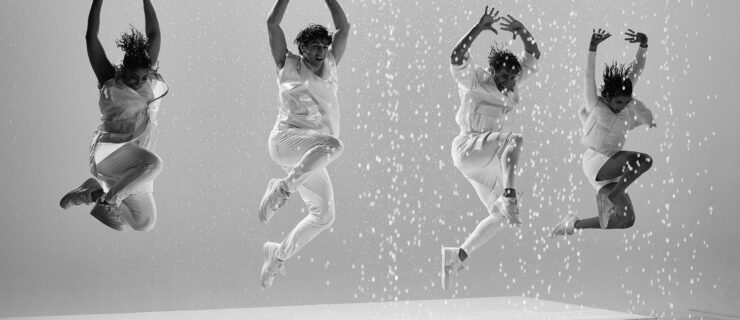A Day in the Life of a Dance Competition Judge
All your practice and prep for a competition leads up to the moment when you hit your final mark and look up at the judges’ table. But do you ever wonder what their experience is like? Follow along with Dana Wilson—a dancer, choreographer, member of The Seaweed Sisters trio, and faculty member/judge for New York City Dance Alliance—on a typical day of teaching, judging, and doing a fair bit of juggling.
7 am
I’m on a quest for caffeine to warm my soul before I warm up my body. In a life full of unknowns, I really cling to the routine of a morning coffee. Every city and venue is different, so finding said caffeine can be an adventure all on its own. I find the only coffee shop nearby and wait close to 35 minutes for a latte. It’s going to need to be a quick warm-up.
8 am
At the welcome rally, the faculty and assistants are introduced like rock stars! I actually love this part of the day, because backstage it’s the quiet before the storm, and the faculty has a bit of time to catch up with each other.
 Wilson (in hat) with assistants and fellow faculty members (Evolve Photo)
Wilson (in hat) with assistants and fellow faculty members (Evolve Photo)
9 am
Classes begin. I usually start with the youngest ones—there is no better way to start the day than by dancing with a room full of 7 to 10 year olds who have so much potential. I can’t help but look at them and wonder what they’ll be up to when they’re my age.
 Teaching class (Evolve Photo)
Teaching class (Evolve Photo)
11 am
Time to sneak in a workout and some food. The goal is to not get cold or fall into a slump between classes. Most hotels have decent gyms with cardio equipment and some free weights, but this weekend I got lucky and was in walking distance of a Peloton studio. I find spinning to be a perfect complement to dance. If you keep the right form, it elongates your muscles, strengthens your core, and has minimal impact on joints. BIG. LOVE.
 Post-workout (courtesy Wilson)
Post-workout (courtesy Wilson)
I try to eat a high-fat and high-protein lunch before the competition to keep me from crashing and snacking at the table. (Do you know there’s practically no silent food? Someone should get on that.) Luckily, today we’re right in the middle of a huge mall with plenty of options. I eat half a Chipotle bowl with chicken, black beans, and plenty of sour cream and guacamole.
1 pm
Usually my last class goes by super-fast, then I head back to my hotel room to recover, relax, and get ready. A shower is definitely in order, and my knees are feeling it from dancing on hard flooring. I’ve learned it’s easier to find ice than something to put it in, so I never go to a convention weekend without silicone bags for icing. These are a great environmentally friendly option, and they take up almost no space in my bag.
 Recovering from a long day of teaching (courtesy Wilson)
Recovering from a long day of teaching (courtesy Wilson)
3:30 pm
Before the performances begin, I set up my judging area with two insulated water bottles: one for cold water, to keep me alert, and one for warm water to soothe my vocal cords. I’m almost always hoarse after classes. I also keep a notepad to write down ideas and songs that I want to look up later—the pieces can be very inspiring. I drape an electric heated blanket around my lower back and hips.
In a single night of competition, I can expect to see between 75 and 150 dances, and at NYCDA we frequently judge two nights back to back. For each piece, I fill out a full sheet of feedback. Our judging criteria are printed on the page, and we’re encouraged to give brief but effective notes so that we can keep our eyes on the dancers. I have to wrap it all up in the time it takes for the current number to be thanked and the next dance to be introduced. Then those sheets get handed down the row to a tabulator, who handles all the numbers, thank goodness.
 Wilson (far right, in hat) with the NYCDA faculty (Evolve Photo)
Wilson (far right, in hat) with the NYCDA faculty (Evolve Photo)
Sometimes an extended period of slow-tempo contemporary dances with droning music can seem to go on forever, but when the talent is great, an eight-hour shift can flash by. Plus, we always get breaks when we need them. (If you’ve ever seen a note being passed to the head of the table, it’s probably a bathroom request.)
At dinner halfway through the program, there’s usually chatter about the outstanding things we’ve seen. My favorite moments tend to be when someone messes up or, better yet, completely forgets what they’re doing. In those moments, the dancer is fully present and it’s so visceral. I’m fascinated by those moments and how dancers recover.
11:30 pm
I did it! I sip tea, catch up on email, and make sure my playlists and combinations are ready for tomorrow’s classes. I’m exhausted, but got to dance or talk about dance literally ALL DAY. When I go to sleep, I get the thought that the future of dance is in good hands. These ambitious young ones are learning to make all the right moves.
A version of this story appeared in the March 2019 issue of
Dance Spirit with the title “A Day in the Life of a Competition Judge.”




